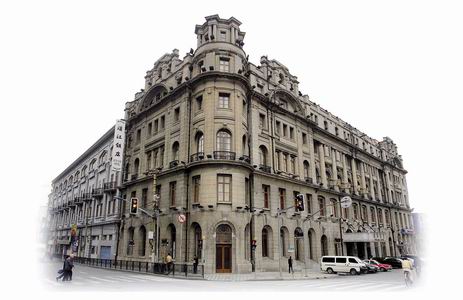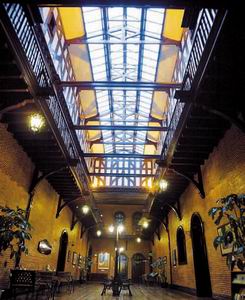Shanghai Daily news

The Pujiang Hotel in the northern area of the Bund was
the first major hotel to be built in Shanghai when it was known as the Astor
House Hotel.(Photo: Shanghai Daily)

A look at part of the hotelí»s interior. (Photo:
Shanghai Daily)
Shanghai's first-ever hotel was a sea captain's hostel that became a legend -
over-the-top luxury, mod cons and celebrities. Tina Kanagaratnam investigates
the history of the Astor House Hotel, and finds connections to everything from
Shanghai's first taxi to the world's most famous ballerina.
From the Peace
Hotel to the Grand Hyatt, Shanghai's landscape has been defined by hotels - so
it is a little strange to imagine a Shanghai without one. But that was the case
until 1846, when the city's first hotel opened.
It was just four years after
the Treaty of Nanjing, the catalyst for the creation of the British Settlement,
and interest in this new treaty port was high. Called the Richard Hotel, after
the American sea captain of the same name who was its first owner, the hotel was
initially targeted at the seafaring clientele that made up the bulk of travelers
to 19th century Shanghai.
Information on the Richard Hotel is scarce, but one
contemporary account describes corridors and floors whose color and design
echoed those on ships. A string of sea captains followed the original as
managers of the hotel, but perhaps life on land did not suit them, for by 1860,
the hotel was sold to Henry Smith, who changed the name to the Astor House
Hotel.
Why the name Astor House? Perhaps it was an attempt to be associated
with Astor House in New York, built in 1836 by John Jacob Astor, the richest man
in America. Astor House, which was located on Broadway, was the city's first
luxury hotel, with amenities that included running water in every room.
The
Shanghai Astor House appears to have no connection to the New York one, but then
again, maybe it did: Astor was no stranger to China, having made a fortune in
China by selling Turkish opium and bringing back tea.
Perhaps it was the
American connection, perhaps it was the intimation of luxury or perhaps there
was nowhere else to stay in Shanghai - but whatever the reason, this was where
(then former) US President Ulysses S. Grant stayed when he visited Shanghai in
1879.
There is little information on the original location of Richard Hotel,
but it is very likely that it was located on the Bund side of Suzhou Creek,
since until 1856, the only way to cross the Suzhou Creek was by ferry. Residents
of the British and the American concessions found this inconvenient, and in
response, a British entrepreneur built a wooden bridge, naming it after himself:
Wills Bridge.
But his system of requiring the payment of one copper coin from
the Chinese who crossed the bridge - but letting foreigners cross on credit -
caused a great deal of dissent, and the bridge and its toll system were
eventually dismantled. A floating bridge (operated by the Shanghai Municipal
Council) followed, and in 1906, the steel bridge that the foreigners called the
Garden Bridge (as it ran next to the Shanghai Public Gardens) and the
Shanghainese called "Waibaidu."
That same year, the Astor House Hotel moved
to its current location at the north end of the Garden Bridge, no doubt because
of an unbeatable combination of lower priced land and convenient access. The
following year, three years of construction began on the block-long, lavish
Victorian beauty that has been there ever since. Like its New York namesake, the
new Astor House Hotel became a magnet for the rich, famous and
notorious.
Shanghai historian and author Tess Johnston quotes from a
contemporary description in "The Last Colonies: Western Architecture in China's
Treaty Ports": "The grand staircase, with marble dado and red panels on white
background, leads upward to passenger lifts, a ladies cloak room, a very
prettily furnished ladies' sitting room, a reading room with several comfortable
sofas and easy chairs upholstered in leather, a private buffet with a polished
teakwood bar, and a large billiard room.
"Farther up the grand staircase is
the main dining hall, almost the whole length of the building with a gallery and
verandah on the second floor and well lighted by a barreled ceiling of glass. On
the Astor Road side is a handsome banqueting hall and reception rooms, both
decorated in ivory and gold, and six private dining rooms."
There were six
service elevators, bedrooms with private sitting rooms, and luxury suites under
the dome. An advertisement in Social Shanghai in 1910 bragged, "The Astor House
Hotel is the most central, popular and modern hotel in
Shanghai."
Newspaperman John Benjamin Powell, one of the "Missouri mafia" who
dominated Shanghai's journalism circles in the pre-1949 era, arrived in Shanghai
on a rainy February day in 1917. In those days, boats docked on the Bund, and
Powell recounts in his memoir, "Twenty-five Years in China," negotiating the
treacherously muddy path from the Bund to the haven that was the Astor
House.
He recalls the high society that came here: the American consul
general, bankers, tycoons, all beautifully dressed. And he recalls the words of
an old-timer: "if you look around with open eyes, you will find all the
swindlers who have drifted into this city."
In 1923, the Astor House Hotel
and other Shanghai hotels (including the Palace Hotel) were acquired by Hong
Kong Hotels Ltd, making them Hong Kong and Shanghai Hotels Ltd, a name the
company still carries. The Astor House became a flagship for the newly-formed
company, so much so that even today, a vintage image of the hotel graces the
"history" pages on the company's Website.
Hong Kong and Shanghai Hotels were
owned by the Kadoories, a Sephardic Jewish family that grew to become one of
Shanghai's wealthiest. Born in Baghdad in 1867, Sir Ellis Kadoorie came to
Shanghai in 1880 to work for David Sassoon & Company, the stepping stone for
many Sephardic Jews who arrived in Shanghai, and then went on to make their
fortunes here. Sir Ellis Kadoorie and his sons, Lawrence and Horace, were savvy
businessmen and smart hoteliers, and under their direction, the Astor House
thrived.
As befits a top-class luxury hotel, the Astor House was eager to be
the first in Shanghai with the latest mod cons: the first electric lights,
telephone, talkies, and the first ball, ending the social stricture that women
should not attend social events. Local lore has it that an Astor House bellboy,
rewarded for recovering a Russian guest's wallet with its contents, spent a
third of it on a car. That car became Shanghai's first taxi, and spawned the
Johnson fleet, now known as the Qiangsheng taxi.
Every celebrity who came to
Shanghai stayed at Astor House: in 1920, the philosopher Bertrand Russell; in
1922, Albert Einstein and in 1927, an eight-year-old girl named Peggy Hookham
came to live at the Astor House with her family. Hookham's father was the chief
engineer for British American Tobacco (which was located just over the bridge,
on then Museum Road), and while she was here, the little girl continued her
ballet lessons, studying with the Russian teachers George Goncharev. The world
today knows her as Margot Fonteyn, perhaps the world's greatest ballerina. In
1931, another great artist stayed here: Charlie Chaplin, who liked it so much
that he came back, in 1936, on his honeymoon (they stayed in Room 404, say the
hotel staff).
During the Japanese invasion of Shanghai, the Astor House Hotel
was briefly the Japanese YMCA in 1941, and then rented out for the duration of
the occupation.
The Astor House Hotel struggled along for a few more years.
Renamed the Pujiang Hotel after the Liberation in 1949, it housed the first
stock exchange in modern China. Today, the old Astor House is a favorite
backpacker hotel, the luxury suites and sitting rooms turned into dorms; the
ballroom quiet and neglected. The interior described in Johnston's account is
now gone, but the faded glory is still stubbornly apparent in the details that
remain.



